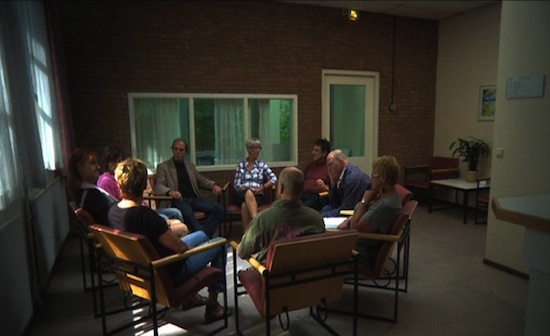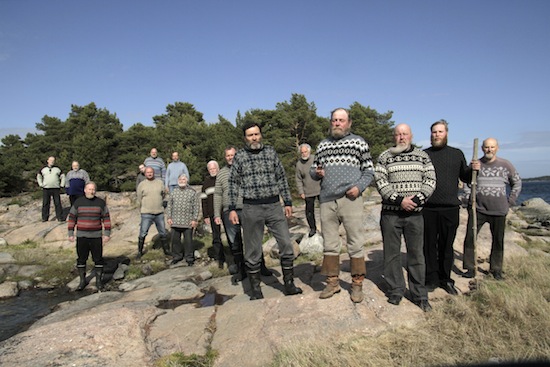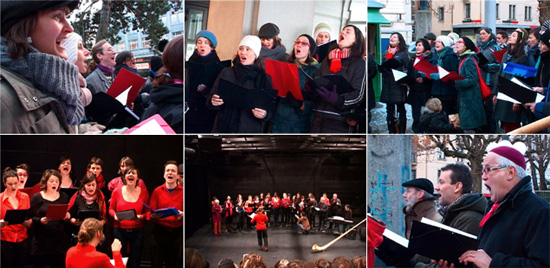Tellervo Kalleinen / Oliver Kochta-Kalleinen
Shedhalle / Exhibitions / Forms of participation / Artists

Kalleinen/Kochta-Kalleinen (FIN): "I love my job" 2008-10 (Videostill)
I Love My Job
8-channel video installation, 2008-2010, each 6'00''
The video installation “I love my Job” restages eight episodes of conflict-laden situations at work places. Incompetent management, reorganisation, and efficiency-oriented demands lead to the destruction of well-functioning systems; mobbing and exclusion turn working conditions into misery and horror. It can be discerned that mobbing and exclusion more often are effects of working conditions than the result of individual malignancy.
No matter what kind of work or which social classes the viewer is confronted with or introduced to, there’s always something involved one can identify with, and – thus – savour it. The reason for this pleasure, above all, lies in the fact that most situations, at the same time, are resolved in an exhilarating or absurd way, and that the movie also elucidates apparently low instincts like spitefulness, revenge, ruse, or triumph. Like in fairy tales, the ones stricken or put to the test escape their nightmares because of their flexibility, their cunning, or pure luck.
These short movies were made on the basis of stories describing the daily horror at work. The artists publicly invited people to tell them about their situations as well as their dreams or wishes how the problems or differences could be resolved. The participants helped in writing the script, in some cases they even played their own role(s). Some of the movies were made with the assistance of professional actors.
There are at least two aspects involved: the staging and the therapy, life and art, a mirror of working conditions in neo-liberalism – and its disruption.
www.ykon.org/kochta-kalleinen/

Kalleinen/Kochta-Kalleinen (FIN): "People in White" 2011 (Videostill)
People in White
Movie, 2011, 64'00''
“People in White” investigates the complex relationship between physician, therapist, and patient, as told subjectively by patients, and focusing on the a-symmetrical power relations. By advertising in daily newpapers, the artists instantly found nine persons willing to tell their partly traumatic experiences and share them with the whole group; more than half of them were willing to re-stage them in front of the camera, too. In the beginning of the film, one seems to be witnessing a group therapy session but gradually the film reveals that it is being staged. It always returns to this initial setting but confronts the viewer with different situations – ranging from successful and very respectful treatment to institutional violence, abuse of power and/or dependence. In the course of the film, the individual experiences and situations are being exchanged, thus every person finds him- or herself in different roles: once being the physician or therapist, then again being the patient.
Roles are being swapped not only in the film. Frontal portrait points-of-view are directed at the viewer and force us to assume a certain position. The assignments’ shifting boundaries elicit a strange mixture of experiences, feelings, and taking sides. By blurring these roles of the people, the artists open up new perspectives of this important topic that is widespread but, in our societies, to a certain extent still a taboo subject.
www.ykon.org/kochta-kalleinen/

Henrik Andersson: «Archipelago Science Fiction» (2012)
Archipelago Science Fiction
4-channel video installation, 2012, each 6'00''
What could your island look like in 100 years? What in the best case, and what in the worst case? Which people would live on it, how would they move, how would they be housed? Those were the questions Tellervo Kalleinen and Oliver Kochta-Kalleinen, in collaboration with Henrik Andersson, asked the inhabitants of the islands of Korpo, Utö, and Houtskär, in the archipelago of Turku, Finland, when they initiated this project. Intensive interviews and three workshops, in the course of which the participants pooled their visions and wrote the accompanying scripts, and the filming lead to four science fiction scenarios: Paradise of the Rich, Life-Style Immigration, Neo-Capitalism, and Outdoor Museum. Like in any science fiction movie, it soon becomes clear that it is all about the future but, at the same time or even more so, it involves questions of how present-day decisions influence the world of tomorrow, or what could be called a “good life”.
Scenario 1, Paradise of the Rich: By the year 2111, the archipelago has changed into a globally acknowledged health centre aiming at a prolongation of life and rejuvenation. With the help of bio- and other technologies, the rich population, which is getting older and older, is able to lead a comfortable life and, by taking a pill, render death a joyful event.
Scenario 2, Life-Style Immigration: By the year 2111, the archipelago has become an autonomous zone in the world. Each island has cultivated its own life style: the eco-anarchists on Ytterholm, and the Real Swedes on Korpo. Many people from all over the world want to live on one of these islands to escape the stream-lined life elsewhere, and apply for immigration. The welcome centre on Utö, however, focuses more on the calculations of the artificial intelligence and its indications than on the wishes expressed.
Scenario 3, Neo-Capitalism: By the year 2111, the archipelago is a post-apocalyptical world. In the year 2061, an epidemic eradicated a large part of the world population. A few hundred survivors live together like in tribes. The aged, who got through the epidemic, deem capitalism responsible and take good care that no new capitalistic tendencies can develop.
Scenario 4, Outdoor Museum: Large parts of the archipelago are owned by the Chinese WEI-LUN Development Bank. The whole archipelago has been turned into an amusement park for Chinese middle-class tourists. The inhabitants of the island stage the living conditions of former centuries and are paid for that.

Kalleinen/Kochta-Kalleinen (FIN): "Dreamland" 2010 (Videostill)
Dreamland
Installation with video and text, 2010, 58'00''
According to Sigmund Freud, dreams are the royal road to the unconscious. Dreams, if we are able to read them, show us the wishes, fears, or hopes we have, reveal what we try to conceal or suppress. For their video installation “Dreamland”, Tellervo Kalleinen and Oliver Kochta-Kalleinen collected dreams that involved the President of Finland, Tarja Halonen. They chose 22 of the 85 dreams that were sent to them and staged them, partly with the persons who had submitted their dreams. The result is a colourful mixture of dreams in which one can see the president blatantly working out at a summit, or drinking beer and singing karaoke songs, or finds herself with her husband rolling in the hay. In one instance she’s a loving mother, then the ruler, cold as ice, then in a coma, dead from the neck up.
The large number of dreams submitted emphasises that the president actually is on the people’s minds. “Dreamland” does not primarily reveal the changing roles a representative of state authority has to assume, it rather depicts how she is perceived and experienced individually. Although the realistic aesthetics of the films, at first glance, does not seem to correspond to oneiric images, Kalleinen/Kochta-Kalleinen do use methods of dream work as filmic means: For example, there are four women playing the president, who has different looks and is different person time and again, thus subverting the concept of subjective unity and stability. This flow of subjects refers to the so called “shift” by which one person can assume different appearances in a dream. The video also shows that single dreams don’t have fixed boundaries but are part of a collective flow: All dreams are shown in one sequence, the viewer cannot be sure where one dream ends and where the next dream starts. Just like dreams themselves that, again and again, spin around a similar subject in many different ways.
www.ykon.org/kochta-kalleinen/

Kalleinen/Kochta-Kalleinen (FIN): "Complaints Choirs" 2010 (Foto: Shedhalle)
Complaints Choirs
Installation, 2005, work in progress
Who would have thought that the idea of the Complaints Choirs, initiated by Tellervo Kalleinen and Oliver Kochta-Kalleinen, would become such a success? By now, there exist more than 80 Complaints Choirs, all around the world, in Tokyo, e.g. with 180 people joining in. In Zurich, the Complaints Choir organised by Shedhalle in 2010 got a lot of attention, too. For this reason and taking new documentation into account, we are having a look back and asking which kind of participation manifests itself in the choirs.
Tellervo Kalleinen/Oliver Kochta-Kalleinen started out from the Finnish word “Valituskuoro”, meaning “Complaints Choir”, and the idea involved, i.e. that people get together to complain in common, singing. The first Complaints Choir was organised in Birmingham, the so called “arsehole of England”, in 2005. People having complaints were, by flyers, invited to join local musicians to rehearse and then perform their complaints publicly. After the big success in Birmingham, the two artists were invited to cities all over the world to organise Complaints Choirs, by now they no longer can direct them themselves. The concept is open like an open-source-project and continuously documented on YouTube. The aim is to communicate one’s seemingly subjective problems to a temporary community, and thus share it with others. It shows in an impressive way that any problem, insignificant as it might seem, is of importance. To Tellervo Kalleinen/Oliver Kochta-Kalleinen singing the complaints represents one stage of becoming or being aware that ‘there’s something wrong’, that one has to speak out about it, then maybe deeds will follow but they don’t necessarily have to. Maybe it is this non-hierarchical and free dealing with things that makes the project such a promise.
www.complaintschoir.org
